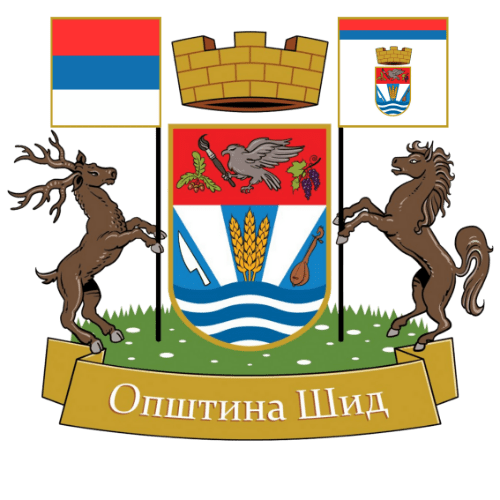About the municipality
The Municipality of Šid
The Municipality of Šid is situated on the southwest part of Vojvodina, actually, in the west part of its province Srem. It is surrounded on one side by the river Danube and the mountain Fruška Gora, and on the other side by the rivers of Sava and Bosut. Good geographical position, endless oak, linden and acacia forests, fertile land, picturesque and rich villages and beautiful landscapes, excellent road networks, suitable for transport and travelling make this Municipality attractive for living and for new investments. Šid is the administrative centre of the Municipality and institutions, but above all the commercial, financial, industrial, cultural, and educational centre of the Municipality. The town of Šid , and eighteen villages, make this Municipality as one of the most important geostrategic points of Republic of Serbia. The vision of further development, defined plans, friendly and hardworking people, trained and professional workers and a large number of highly educated people contribute to prosperity of this area.

Geography
The Municipality of Šid is situated between the borders of three countries: Republic of Serbia, Republic of Croatia and Republic of Srpska (Bosnia and Herzegovina). It is located on the southwest part of Vojvodina, exactly, on the west part of Srem. The Municipality of Šid covers the area of 686 km2. Total number of inhabitants in the Municipality of Šid, as per data from 2011, is 34.188 inhabitants.
All of the nineteen inhabited villages and a town which form the Municipality of Šid, are as follows:
Šid with 14.893 inhabitants,
Erdevik with 2.726 inhabitants,
Kukujevci with 1.955 inhabitants,
Adaševci with 1.919 inhabitants,
Morović with 1.774 inhabitants,
Višnjićevo with 1.683 inhabitants,
Vašica with 1.424 inhabitants,
Bačinci with 1.180 inhabitants,
Berkasovo with 1.115 inhabitants,
Gibarac with 989 inhabitants,
Jamena with 960 inhabitants,
Bingula with 732 inhabitants,
Ilinci with 804 inhabitants,
Sot with 679 inhabitants,
Ljuba with 446 inhabitants,
Bikić Dol with 269 inhabitants,
Batrovci with 259 inhabitants,
Molovin with 195 inhabitants and
Privina Glava with 186 inhabitants.
Šid is the most populated settlement in the Municipality and may be considered as the urban settlement. The other places may be considered as the villages.
All these places are different. They differ from each other based on the geographic and topographic positions, on the size and natural and economic characteristics.
People who live in Municipality of Šid are different nationalities, such as Serbs, Croats, Slovaks, Ruthenians, Hungarians, and Roma. Some other nationalities are also present, but in very small numbers.
The Municipality of Šid has six border crossings: Ljuba, Sot, Šid, Batrovci, Jamena and Šid-train crossing.
The Municipality is connected with other neighboring countries by roads and railroad networks that passes through and around Šid.
The Municipality of Šid is 104 km far from Belgrade, the capital city of Serbia (via Adaševci) and 64 km from Novi Sad, the administrative center of the Autonomous Province of Vojvodina (via Ilok).

History
The territory of the municipality of Sid was inhabited long time ago. The first traces of the past indicate that there was life in this area even in prehistoric time. The prehistoric settlements were built near river, at the places where water, food, wood, reed or venison were available. Gradina on the Bosut river is very impressive archeological site with a complex of cultural inventory from the Neolithic era to the Roman period.
The Romans left a lot of traces in this area. They built roads for military-strategic purposes which were going through the territory of the municipality. Archeological findings such as gold helmets, silver coins, sarcophagus, parts of horse equipment and many other things are proves for Roman settlements along those roads.
After Romans left, the Huns, Germans and Avars invaded the area of the Municipality of Šid, as well as the whole area of Srem. They ruled and they were present in this area for over two centuries.
Slavs arrived together with Avars. Their presence in the Middle Age are supported by many monuments such as Despotovac, the old town of Berkasovo. This town belonged to Despot Vuk Brankovic (ZmajOgnjeniVuk) while the fortress in the village nearby, Morović, belonged to Despot Stefan Stiljanović.
At the beginning of the 18th century, the military border was established along the rivers of Sava, Danube, Tisa and Moriš to protect European continent on the west from the ambitions of the Ottoman Empire. The military center was situated in Petrovaradin.
The monuments from the First and Second World Wars testify the events that occurred in the area of the Municipality of Šid
at that time. The largest front operation on the territory of former Yugoslavia during the Second World War, Srem’s Front (Sremski Front), took place at the twelfth kilometers from Šid. During that operation, more than 13,000 soldiers of the National Army, 1,100 soldiers of the Red Army, 623 soldiers of the Bulgarian National Army and 163 fighters of the Italian Brigade were killed. Today, there is The Memorial Park where the names of all victims who sacrificed their lives for our freedom, are written.



